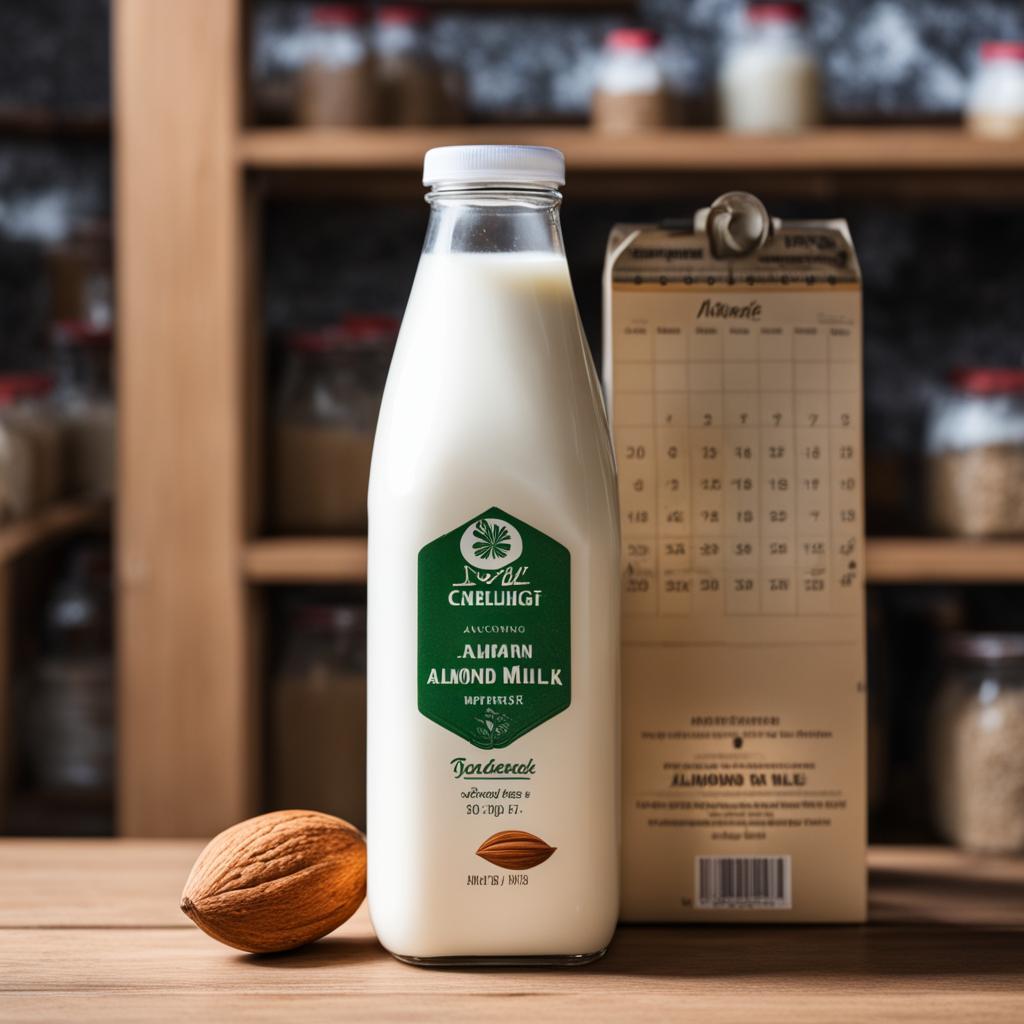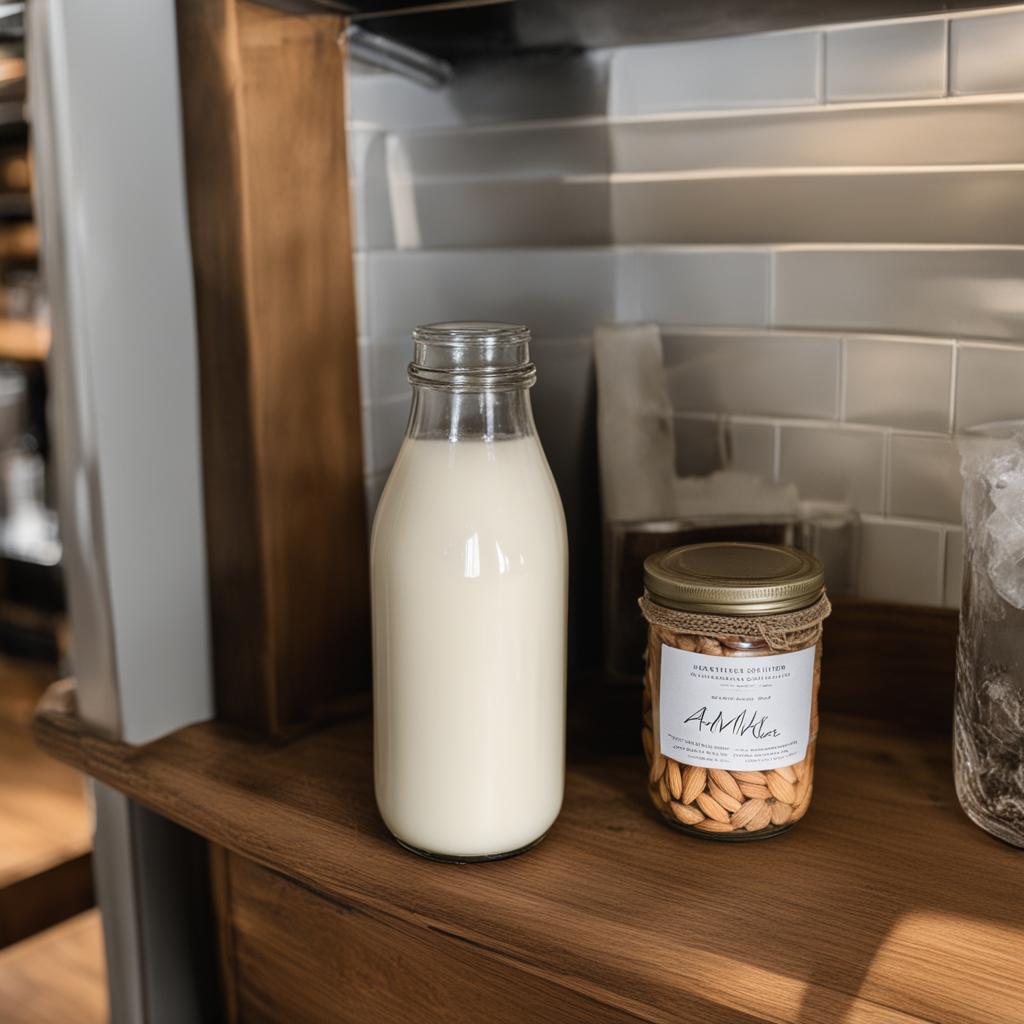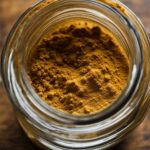Are you wondering if almond milk can go bad? Well, the answer is yes. Just like any other perishable food item, almond milk has a shelf life and can eventually spoil. However, the shelf life of almond milk depends on various factors, including the type of almond milk and how it is stored. In this article, I will explain the different types of almond milk, their shelf life, signs of spoilage, and provide you with some useful storage tips to keep your almond milk fresh for as long as possible.
Key Takeaways:
- Almond milk has a shelf life and can spoil over time.
- The shelf life of almond milk depends on the type and how it is stored.
- Homemade almond milk lasts for about 3 to 7 days.
- Refrigerated almond milk can last up to 7 days once opened.
- Shelf-stable almond milk can last for 4 to 6 weeks unopened, but should be refrigerated after opening and consumed within 7 to 10 days.
- Proper storage in the fridge or pantry is essential to prolong the freshness of almond milk.
Types of Almond Milk and Shelf Life
When it comes to almond milk, there are different types available, each with its own shelf life. Understanding the various types of almond milk and their respective storage durations can help you make informed decisions about your milk’s freshness and consumption. Here, I’ll delve into the different varieties of almond milk and how long they can last.
Homemade Almond Milk
The first type is homemade almond milk, which is made by blending almonds with water and straining the mixture. Homemade almond milk has a shorter shelf life compared to other types. Typically, it can last for about 3 to 7 days when stored in the refrigerator. After this time, it may begin to spoil and develop an off taste.
Commercially Bought Refrigerated Almond Milk
Commercially bought refrigerated almond milk, found in grocery stores, has a longer shelf life than homemade almond milk. Once opened, it can last for up to 7 days if properly refrigerated. It is important to follow the instructions on the packaging and consume it within the recommended time frame to ensure its freshness.
Shelf-Stable Almond Milk
Shelf-stable almond milk is another variety that can be stored at room temperature until it is opened. However, once the container is opened, it should be kept in the refrigerator and consumed within 7 to 10 days. Shelf-stable almond milk is packaged in a way that helps preserve its freshness, but refrigeration is necessary once it is exposed to air.
| Type of Almond Milk | Shelf Life (Unopened) | Shelf Life (Opened) |
|---|---|---|
| Homemade Almond Milk | 3 to 7 days | N/A |
| Commercially Bought Refrigerated Almond Milk | Until the best-by date | Up to 7 days |
| Shelf-Stable Almond Milk | 4 to 6 weeks | 7 to 10 days |
It is important to note that these shelf life estimates are general guidelines, and the freshness of almond milk ultimately depends on factors such as storage conditions and any signs of spoilage. Always use your senses to determine if the almond milk is still safe to consume, checking for any unusual smells, textures, or flavors.
Signs of Almond Milk Going Bad
When it comes to determining if almond milk has gone bad, there are several key signs to look out for. These indicators can help you decide whether it’s safe to consume or if it’s time to discard the milk. It’s always important to trust your senses and be cautious when it comes to food safety.
1. Bloated Carton: One of the first signs of spoiled almond milk is a bloated or swollen carton. If you notice the packaging is puffed up or deformed, it could indicate that the milk has spoiled and is no longer safe to consume.
2. Weird Smell and Appearance: Another telltale sign is a strange or sour smell coming from the almond milk. If it has an off-putting odor or looks curdled, clumpy, or discolored, these are clear signs that the milk has gone bad.
3. Mold or Presence of Sediments: The presence of mold or unusual sediments in the almond milk is a definite indication of spoilage. If you see any visible signs of mold growth or particles floating in the liquid, it’s best to discard the milk immediately.
4. Strange Taste: Lastly, if the almond milk tastes off, sour, or unpleasant, it’s a good indication that it’s no longer fresh. Trust your taste buds and refrain from consuming almond milk that has an unusual or bad taste.
Remember, consuming spoiled almond milk can lead to foodborne illnesses, so it’s important to be vigilant and avoid consuming milk that shows any signs of spoilage.
Why Does Almond Milk Go Bad?
Almond milk can go bad due to several factors that affect its freshness and shelf life. Understanding these reasons can help you take proper measures to prevent spoilage and ensure the quality of your almond milk.
One of the primary factors contributing to almond milk spoiling is the absence of pasteurization in homemade almond milk. Since homemade almond milk is not pasteurized, bacteria present in the ingredients are not killed off, allowing them to multiply and spoil the milk more quickly. Additionally, homemade almond milk is often exposed to oxygen during preparation and storage, which further promotes bacterial growth.
Commercially bought almond milk, on the other hand, is pasteurized to kill bacteria and extend its shelf life. However, once opened, it is exposed to oxygen, which can lead to spoilage. Similarly, shelf-stable almond milk is specially packaged to prevent spoilage before opening, but once the container is unsealed, it still needs to be refrigerated to maintain freshness and prevent bacterial growth.
Proper storage and handling play a significant role in preventing almond milk from spoiling too soon. By refrigerating almond milk promptly, tightly sealing the container, and following the recommended storage guidelines, you can help preserve its freshness and extend its shelf life.
Factors Affecting Almond Milk Freshness
Several factors can affect the freshness of almond milk:
- Temperature: Almond milk should be stored at a consistent, cool temperature. Refrigeration is crucial for both homemade and commercially bought almond milk to slow down bacterial growth.
- Exposure to oxygen: Oxygen exposure can accelerate spoilage, especially once almond milk is opened. It is essential to seal the container tightly after each use.
- Contamination: Proper hygiene during the preparation and handling of almond milk is vital to prevent contamination by harmful bacteria.
- Storage containers: Using clean and sterilized containers for homemade almond milk can help maintain its freshness.
By understanding and addressing these factors, you can ensure that your almond milk stays fresh and enjoyable for as long as possible.
| Factors | Effects |
|---|---|
| Temperature | Slows down bacterial growth and extends shelf life |
| Exposure to oxygen | Accelerates spoilage |
| Contamination | Increases the risk of harmful bacteria presence |
| Storage containers | Helps maintain freshness and prevent contamination |
Can Almond Milk Be Left at Room Temperature?
When it comes to almond milk, it’s important to handle and store it properly to maintain its freshness and prevent spoilage. Leaving almond milk at room temperature for an extended period is not recommended. According to the USDA, perishable foods, including almond milk, should not be left out in room temperature conditions for more than 2 hours.
Leaving almond milk unrefrigerated creates an ideal environment for bacteria to grow, which can lead to spoilage and potential illness. To ensure the safety and quality of almond milk, it should be refrigerated as soon as possible, especially if it has been opened. Proper storage is essential for prolonging the shelf life of almond milk and preserving its freshness.
However, it’s important to note that shelf-stable almond milk can be stored at room temperature until it is opened. Once opened, it should be refrigerated and consumed within the recommended time frame. It’s always best to follow the storage guidelines provided by the manufacturer to ensure the highest quality and safety of the almond milk.
By storing almond milk properly and refrigerating it when necessary, you can enjoy fresh and safe almond milk for a longer period. Remember to use your senses to determine if the almond milk has gone bad, and discard it if you notice any signs of spoilage. With proper storage and handling, you can maximize the freshness and quality of your almond milk.
Table: Storage Guidelines for Almond Milk
| Type of Almond Milk | Unopened Shelf Life | Opened Shelf Life (Refrigerated) |
|---|---|---|
| Homemade Almond Milk | 3 to 7 days | 3 to 7 days |
| Refrigerated Commercially Bought Almond Milk | – | Up to 7 days |
| Shelf-stable Almond Milk | 4 to 6 weeks | 7 to 10 days |
Storing Almond Milk Properly
Proper storage is essential to keep almond milk fresh for as long as possible. Whether it’s homemade or store-bought, following the right storage techniques can help extend its shelf life and maintain its quality.
For refrigerated almond milk, it should be stored in the refrigerator from the moment you bring it home. Make sure to keep it in the back of the fridge, where the temperature is colder and more consistent. Tightly seal the carton after each use to prevent air and bacteria from entering. This will help preserve the freshness and prevent spoilage.
Shelf-stable almond milk, on the other hand, can be stored in a cool, dark place until it’s opened. Once opened, it should be refrigerated to maintain its freshness. Keeping it tightly sealed is crucial to prevent any contamination and ensure its quality. By following these storage guidelines, you can maximize the shelf life of your almond milk and enjoy it at its best.
| Storage Method | Refrigeration | Pantry |
|---|---|---|
| Homemade Almond Milk | Yes | No |
| Refrigerated Store-Bought Almond Milk | Yes | No |
| Shelf-Stable Almond Milk (Unopened) | No | Yes |
| Shelf-Stable Almond Milk (Opened) | Yes | No |
Table: Comparison of almond milk storage methods
How to Tell If Almond Milk Has Gone Bad
When it comes to almond milk, determining whether it has gone bad is essential to ensure your safety and enjoyment. By keeping an eye out for a few key signs, you can easily tell if your almond milk is still good or if it’s time to toss it out.
Signs of Spoiled Almond Milk
There are several telltale signs that indicate almond milk has spoiled. First, check the appearance of the carton. If it appears bloated or swollen, it may be a sign of bacterial growth inside the milk. Additionally, inspect the almond milk for any clumps or curdling, as this is a clear indication of spoilage.
Next, give the almond milk a sniff. If you detect a strange or sour odor, it’s a strong sign that the milk has gone bad. Similarly, if the milk has developed mold, visible in the form of green or black spots, it is unsafe to consume.
Finally, trust your taste buds. If the almond milk tastes off, sour, or unpleasant, it’s best to discard it immediately. Consuming spoiled almond milk can lead to digestive issues and potential foodborne illnesses.
“If the appearance, smell, or taste of almond milk is questionable, it’s always better to err on the side of caution and throw it away.”
Proper Disposal
If you determine that your almond milk has gone bad, it’s important to dispose of it properly. Pour it down the sink while running water to ensure it is thoroughly rinsed away. This prevents any potential bacterial contamination from lingering in your kitchen.
Summary
Determining whether almond milk has gone bad is relatively straightforward. Keep an eye out for signs such as a bloated carton, clumps, curdling, strange smells, mold, or an off taste. If any of these signs are present, it’s best to discard the almond milk to avoid any potential health risks. Trust your senses and prioritize your safety when it comes to consuming almond milk.
Shelf Life and Expiration Dates
When it comes to almond milk, understanding its shelf life and expiration dates is crucial to ensure its freshness and quality. The shelf life of almond milk can vary depending on the type and brand, so it’s important to be aware of the specific guidelines for each. Here’s a breakdown of the general shelf life for different types of almond milk:
Homemade almond milk: Lasts about 3 to 7 days when stored properly in the refrigerator. It’s important to consume homemade almond milk within this timeframe to ensure optimal freshness.
Refrigerated almond milk: Can last up to 7 days once opened and refrigerated according to storage guidelines. It’s essential to check the expiration date on the packaging and consume the almond milk before it expires.
Shelf-stable almond milk: Has a longer shelf life, typically lasting for 4 to 6 weeks when unopened. Once opened, it should be refrigerated and consumed within 7 to 10 days for the best quality.
It’s important to note that expiration dates on almond milk packaging are more about the quality of the product rather than its safety. The freshness of almond milk should be determined by its appearance, smell, and taste, rather than solely relying on the date on the packaging. Trusting your senses is key in determining if almond milk has gone bad.
Proper storage and handling are essential in maximizing the shelf life of almond milk. Store refrigerated almond milk in the back of the refrigerator, where temperatures are colder and more consistent. Ensure that the container is tightly sealed to prevent air and bacteria from entering. Shelf-stable almond milk can be stored in a cool, dark place until opened, but once opened, it should be refrigerated. By following storage guidelines and monitoring the milk for any changes, you can enjoy almond milk at its freshest.
| Type of Almond Milk | Shelf Life | Expiration Date (Once Opened) |
|---|---|---|
| Homemade | 3 to 7 days | N/A |
| Refrigerated | Up to 7 days | Check packaging |
| Shelf-stable | 4 to 6 weeks (unopened) | 7 to 10 days (opened and refrigerated) |

Summary:
Almond milk has a varying shelf life depending on whether it’s homemade, refrigerated, or shelf-stable. It’s important to consume almond milk within the recommended timeframe to ensure freshness and quality. Expiration dates on almond milk are more about the product’s quality than its safety, so it’s essential to trust your senses when determining if the milk has gone bad. Proper storage and handling, such as refrigeration and sealing the container tightly, help maximize the shelf life of almond milk. By following these guidelines, you can enjoy almond milk at its best.
What to Do with Bad Almond Milk
Unfortunately, almond milk can sometimes go bad before we have the chance to consume it. When you notice signs of spoilage, it’s important to discard the milk to avoid any risks to your health. But don’t fret, there are plenty of alternatives to replace spoiled almond milk.
One option is soy milk, which is made from soybeans and has a similar creamy texture to almond milk. Rice milk, made from milled rice and water, is another dairy-free alternative that can be used in various recipes. Oat milk, made from oats and water, has a slightly thicker consistency and can provide a nutty flavor to your dishes. Hazelnut milk and coconut milk are additional options that offer unique flavors and textures.
When choosing an alternative to almond milk, consider your personal preferences and the intended use of the milk. Some alternatives may work better in coffee or baking, while others may be better suited for drinking on their own. The best part is that these alternatives are widely available in grocery stores and online, making it easy to find a replacement for your spoiled almond milk.
Table: Dairy-Free Alternatives to Almond Milk
| Alternative | Taste | Texture | Dietary Benefits |
|---|---|---|---|
| Soy Milk | Mild and slightly nutty | Creamy | High in protein and calcium |
| Rice Milk | Mild and slightly sweet | Thin and watery | Low in fat and cholesterol |
| Oat Milk | Creamy and slightly sweet | Thick and smooth | Good source of fiber and vitamins |
| Hazelnut Milk | Nutty and slightly sweet | Creamy | Rich in healthy fats |
| Coconut Milk | Sweet and tropical | Rich and creamy | Contains medium-chain triglycerides |
Exploring these dairy-free alternatives can be an exciting journey to find your new favorite milk substitute. Don’t be afraid to try different options and experiment with them in your favorite recipes. With the wide variety of choices available, you’re sure to find a delicious and suitable replacement for your spoiled almond milk.
The Importance of Proper Storage
Proper storage is essential when it comes to maximizing the shelf life of almond milk. By following the recommended guidelines, you can ensure that your almond milk stays fresh and delicious for as long as possible. Whether you are using homemade, refrigerated, or shelf-stable almond milk, proper storage techniques are crucial.
For homemade almond milk, it is important to refrigerate it immediately after it is made. Homemade almond milk has a shorter shelf life compared to commercially bought options, typically lasting about 3 to 7 days. To maintain its freshness, store it in a sterilized container with a tight seal to prevent oxygen from entering, which can promote bacterial growth.
Refrigerated almond milk should always be stored in the refrigerator, preferably in the back where the temperature is colder and more consistent. This helps to maintain its freshness and extends its shelf life. Keep the container tightly sealed after each use to prevent air and bacteria from entering.
Shelf-stable almond milk can be stored in a cool, dark place until it is opened. However, once it is opened, it should be immediately refrigerated to maintain its freshness. It is important to follow the storage instructions provided on the carton to ensure the quality and safety of the almond milk.
Summary:
Proper storage is crucial for maximizing the shelf life of almond milk. Homemade almond milk should be refrigerated and consumed within a few days. Refrigerated almond milk should always be stored in the refrigerator, while shelf-stable almond milk should be refrigerated once opened. By following the recommended storage guidelines, you can enjoy fresh and delicious almond milk for a longer period.
How to Store Homemade Almond Milk
Storing homemade almond milk properly is essential to maintain its freshness and ensure it stays safe for consumption. When handling and storing homemade almond milk, following a few simple steps can help prolong its shelf life and preserve its quality.
Cooling and Sealing
After making homemade almond milk, it is important to transfer it to a clean, sterilized container before storing it in the refrigerator. Make sure the container is tightly sealed to prevent oxygen from entering, as exposure to air can promote bacterial growth and spoil the milk.
Refrigeration and Consumption
Homemade almond milk should be refrigerated as soon as possible to keep it cool and fresh. It is recommended to consume homemade almond milk within 3 to 7 days of making it. Regularly check for any signs of spoilage, such as an off smell or strange appearance, and discard the milk if necessary. If the milk separates, a quick shake can usually mix it back up.
Enjoying Freshness
By storing your homemade almond milk in the refrigerator, tightly sealed, and consuming it within the recommended timeframe, you can enjoy its freshness for longer. Homemade almond milk can be a delicious and nutritious alternative to dairy milk, so make sure to handle and store it properly to maintain its quality.

| Storage Recommendations for Homemade Almond Milk |
|---|
| Transfer freshly made almond milk to a clean, sterilized container. |
| Tightly seal the container to prevent oxygen exposure. |
| Refrigerate homemade almond milk immediately. |
| Consume homemade almond milk within 3 to 7 days. |
| Regularly check for signs of spoilage and discard if necessary. |
Properly storing homemade almond milk ensures that it remains fresh and safe to consume. By following the recommended guidelines, you can enjoy the homemade goodness of almond milk for longer periods.
Proper Handling and Storage for Commercial Almond Milk
When it comes to maintaining the freshness of commercial almond milk, proper handling and storage are key. By following a few simple guidelines, you can ensure that your almond milk stays fresh and delicious for as long as possible.
First and foremost, it is important to always refrigerate your refrigerated almond milk. Keeping it at a consistently cool temperature helps to slow down the natural spoilage process. Additionally, be sure to tightly seal the container after each use to prevent exposure to air and bacteria.
Once opened, refrigerated almond milk should be consumed within 7 days. This ensures that you are enjoying the milk at its peak freshness and flavor. It is also important to regularly check for any signs of spoilage, such as a bloated carton, weird smell, or unusual appearance, and discard if necessary.
For shelf-stable almond milk, it should be stored in a cool, dark place until opened. Once opened, it should be refrigerated and consumed within 7 to 10 days. Following these storage guidelines and paying attention to any changes in the milk’s appearance, smell, or taste will help you maintain the freshness of your commercial almond milk.
Proper Handling and Storage Tips for Commercial Almond Milk:
- Always refrigerate refrigerated almond milk
- Tightly seal the container after each use
- Consume refrigerated almond milk within 7 days of opening
- Regularly check for signs of spoilage
- Store shelf-stable almond milk in a cool, dark place until opened
- Refrigerate shelf-stable almond milk once opened and consume within 7 to 10 days
By following these simple tips, you can ensure that your commercial almond milk stays fresh and delicious for as long as possible. Proper handling and storage are essential for maximizing the shelf life and maintaining the quality of your almond milk.
| Refrigerated Almond Milk | Shelf-Stable Almond Milk | |
|---|---|---|
| Storage | Always refrigerate | Keep in a cool, dark place until opened |
| Once Opened | Consume within 7 days | Refrigerate and consume within 7 to 10 days |
| Signs of Spoilage | Bloated carton, weird smell, unusual appearance | Bloated carton, weird smell, unusual appearance |
Tips for Prolonging Almond Milk Freshness
When it comes to almond milk, proper storage is key to maintaining its freshness and extending its shelf life. Here are some helpful tips to help you prolong the freshness of your almond milk:
1. Store in the Back of the Fridge
To keep your almond milk fresh for as long as possible, store it in the back of your refrigerator where the temperature is colder and more consistent. This helps to slow down the growth of bacteria and maintain the quality of the milk.
2. Keep the Carton Tightly Sealed
Make sure to tightly seal the carton after each use to prevent air from entering and compromising the freshness of the almond milk. This helps to preserve its flavor and texture for a longer period.
3. Follow Recommended Storage Guidelines
Each type of almond milk has specific storage requirements. Homemade almond milk should always be refrigerated and consumed within 3 to 7 days. Refrigerated almond milk should be kept in the fridge at all times and consumed within 7 days after opening. Shelf-stable almond milk can be stored in a cool, dark place until opened, and then refrigerated for 7 to 10 days. It’s important to follow these guidelines to ensure the best quality and freshness of your almond milk.
By following these simple tips, you can prolong the freshness of your almond milk and enjoy its creamy taste for a longer period. Remember to monitor the milk for any signs of spoilage and discard it if necessary. Enjoy your almond milk at its best!
Conclusion
In conclusion, maintaining the freshness of almond milk is essential for enjoying its taste and nutritional benefits. By following proper storage and handling techniques, you can prolong the shelf life of almond milk and avoid consuming spoiled milk. Homemade almond milk should be refrigerated and consumed within 3 to 7 days, while commercially bought almond milk should be refrigerated at all times and consumed within 7 days of opening. Shelf-stable almond milk can last longer if unopened, but once opened, it should be refrigerated and consumed within 7 to 10 days.
To determine if almond milk has gone bad, trust your senses. Look for signs such as a bloated carton, strange odor, clumps or curdling, the presence of mold, or an off taste. These indicators suggest that the almond milk has spoiled and should be discarded. Remember, the expiration date on the packaging is more about quality than safety, so rely on your sensory evaluation to determine the freshness of the milk.
By storing almond milk properly, tightly sealing the container, and refrigerating it promptly, you can maximize its shelf life and enjoy it at its best. Whether you prefer homemade, commercially bought, or shelf-stable almond milk, maintaining its freshness is key. So, take care of your almond milk, indulge in its creamy goodness, and savor every sip!
FAQ
Does almond milk go bad?
Yes, almond milk can go bad. Its shelf life depends on the type of almond milk and how it is stored.
What are the different types of almond milk and their shelf life?
There are homemade, commercially bought refrigerated, and shelf-stable almond milk. Homemade almond milk lasts for about 3 to 7 days. Refrigerated almond milk can last up to 7 days once opened. Shelf-stable almond milk can last for 4 to 6 weeks unopened and 7 to 10 days once opened and refrigerated.
How can I tell if almond milk has gone bad?
Signs of bad almond milk include a bloated carton, weird smell, clumps or curdling, the presence of mold, and a strange taste.
Why does almond milk go bad?
Almond milk can spoil due to factors like lack of pasteurization in homemade almond milk, exposure to oxygen in commercially bought almond milk, and packaging limitations in shelf-stable almond milk.
Can almond milk be left at room temperature?
Almond milk should not be left at room temperature for more than 2 hours according to USDA guidelines. Shelf-stable almond milk can be stored at room temperature until opened, but once opened, it should be refrigerated.
How should I store almond milk properly?
Homemade and commercially bought almond milk should be refrigerated from the start. Shelf-stable almond milk can be stored in a cool, dark place until opened, and then refrigerated.
How can I determine if almond milk has gone bad?
Visual cues like a bloated carton, unusual smell, clumps or curdling, and the presence of mold indicate bad almond milk. Trust your senses and discard if it has a strange taste.
What is the shelf life of almond milk?
The shelf life of almond milk varies depending on the type. Homemade almond milk lasts about 3 to 7 days, refrigerated almond milk lasts up to 7 days once opened, and shelf-stable almond milk can last for 4 to 6 weeks unopened and 7 to 10 days once opened and refrigerated.
What can I use as a replacement for bad almond milk?
Soy milk, rice milk, oat milk, hazelnut milk, and coconut milk are some dairy-free alternatives to almond milk that you can use.
Why is proper storage important for almond milk?
Proper storage helps maintain the freshness and quality of almond milk, reducing the risk of spoilage.
How should I store homemade almond milk?
Homemade almond milk should be stored in the refrigerator and consumed within 3 to 7 days. Keep it tightly sealed in a sterilized container and check for signs of spoilage before consuming.
How should I handle and store commercial almond milk?
Refrigerate refrigerated almond milk at all times and tightly seal the container after each use. Shelf-stable almond milk can be stored in a cool, dark place until opened, and then refrigerated for 7 to 10 days. Monitor for signs of spoilage and follow storage guidelines.
Are there any tips for prolonging almond milk freshness?
Storing almond milk in the back of the fridge, tightly sealing the container, and following recommended storage guidelines for each type of almond milk can help prolong its freshness.
Source Links
- https://www.thekitchn.com/heres-how-to-tell-if-your-almond-milk-is-bad-258188
- https://www.eatingwell.com/article/7961657/does-almond-milk-go-bad/
- https://greatist.com/eat/does-almond-milk-go-bad
Related Recipes:
 Can You Eat Expired Butter? What You Need to Know
Can You Eat Expired Butter? What You Need to Know
 Does Chocolate Syrup Go Bad? What You Need to Know.
Does Chocolate Syrup Go Bad? What You Need to Know.
 Does Garlic Powder Go Bad? How to Store Properly.
Does Garlic Powder Go Bad? How to Store Properly.
 How to Store Carrots? (Perfect Every Time!)
How to Store Carrots? (Perfect Every Time!)
 How to Make Greek Yogurt (No Special Equipment)
How to Make Greek Yogurt (No Special Equipment)
 Do Chia Seeds Go Bad? Shelf Life and Storage Tips
Do Chia Seeds Go Bad? Shelf Life and Storage Tips
 How to Store Parsley? (Perfect Every Time!)
How to Store Parsley? (Perfect Every Time!)
 Can You Freeze Stuffing? How to Preserve the Holiday Dish
Can You Freeze Stuffing? How to Preserve the Holiday Dish








